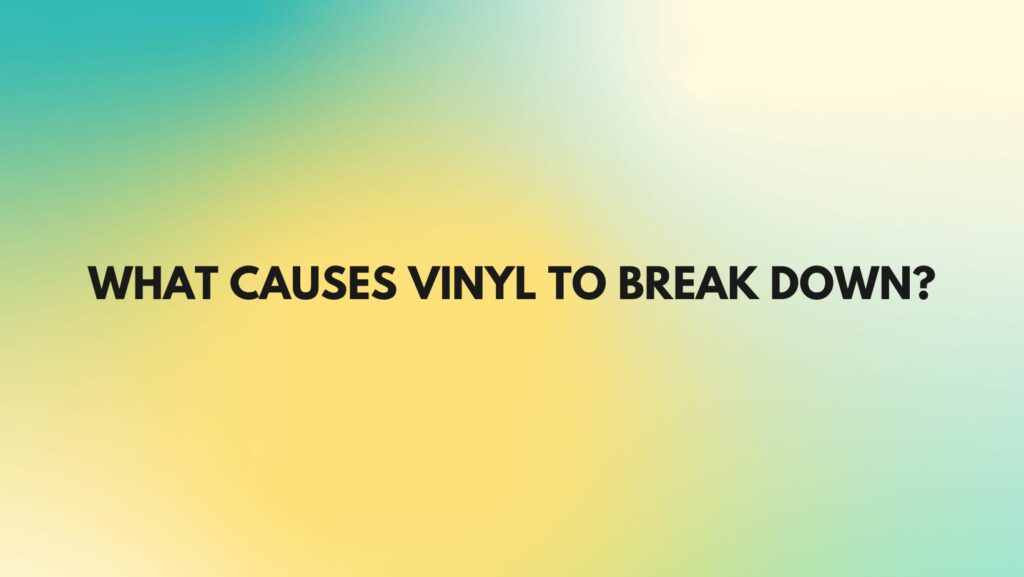Vinyl records, with their distinctive warmth and analog charm, are timeless relics in the world of music. However, the longevity of these sonic treasures can be threatened by a myriad of factors that contribute to vinyl breakdown. In this guide, we’ll delve into the intricate details of what causes vinyl to break down, shedding light on the vulnerabilities of this cherished medium and offering insights into preserving the integrity of your vinyl collection.
- Chemical Composition of Vinyl:
Vinyl records are primarily composed of polyvinyl chloride (PVC), a synthetic plastic. Over time, the chemical structure of PVC can undergo changes, leading to vinyl breakdown. Exposure to environmental elements accelerates this process.
- Heat and Sunlight Exposure:
One of the chief culprits in vinyl breakdown is exposure to heat and direct sunlight. Elevated temperatures can cause the PVC molecules to become more mobile, accelerating chemical reactions that compromise the physical and sonic properties of the vinyl.
- Oxidation and Atmospheric Oxygen:
Oxygen plays a crucial role in the breakdown of vinyl. Oxidation occurs when oxygen interacts with the vinyl molecules, leading to the formation of peroxides. This chemical process weakens the structure of the vinyl and contributes to degradation.
- Humidity and Moisture:
Vinyl records are highly susceptible to moisture, which can lead to mold growth, warping, and other forms of deterioration. Humidity fluctuations can also contribute to the breakdown of vinyl, emphasizing the importance of proper storage conditions.
- Inadequate Storage Practices:
Improper storage practices, such as stacking records horizontally or storing them in damp environments, can exert undue pressure on the vinyl, leading to warping and distortion. Vertical storage in a cool, dry place is essential to mitigate these risks.
- Contaminants and Airborne Particles:
Dust, dirt, and other contaminants settling into the grooves of vinyl records can contribute to breakdown. These particles create friction during playback, causing wear and tear on the vinyl surface.
- Stylus Wear and Poor Turntable Maintenance:
An improperly maintained turntable, including a worn-out stylus or misaligned cartridge, can exert excessive force on the vinyl surface. Over time, this wear and tear can lead to permanent damage and breakdown.
- Chemical Exposure from Cleaning Agents:
While cleaning is essential for vinyl maintenance, using harsh or abrasive cleaning agents can accelerate vinyl breakdown. Chemical reactions with the vinyl material may compromise its structural integrity.
- Age and Vinyl Formulas:
Different vinyl formulations were used during different periods in the history of record production. Some older formulations are more prone to breakdown due to the materials used and the manufacturing processes of the time.
- Manufacturing Defects:
Vinyl breakdown can also result from manufacturing defects. In some cases, impurities in the vinyl, inadequate quality control, or errors during the pressing process can contribute to degradation over time.
- Excessive Playing without Cleaning:
Playing records excessively without proper cleaning allows contaminants to embed themselves into the grooves, contributing to wear and tear that accelerates vinyl breakdown.
Conclusion:
Understanding the factors that contribute to vinyl breakdown empowers collectors and enthusiasts to adopt proactive measures in preserving their cherished collections. From vigilant storage practices to meticulous turntable maintenance and cautious cleaning routines, each step taken to mitigate the impact of these elements ensures that vinyl records continue to offer the timeless and authentic sonic experience that defines the allure of analog playback. As stewards of this rich musical tradition, it is our responsibility to safeguard vinyl from the forces that seek to unravel the magic contained within the grooves.


